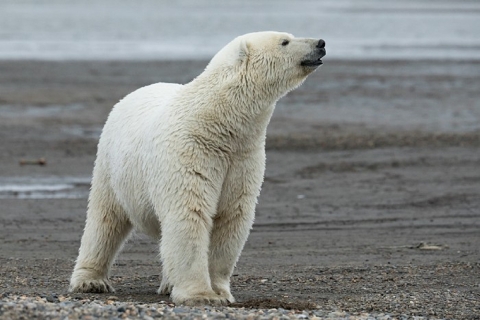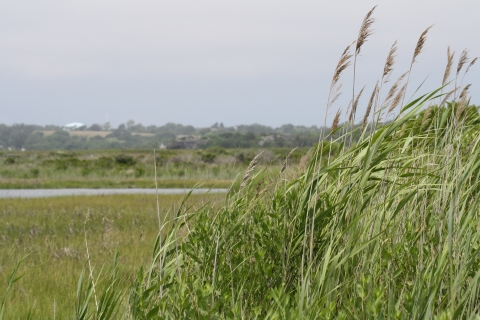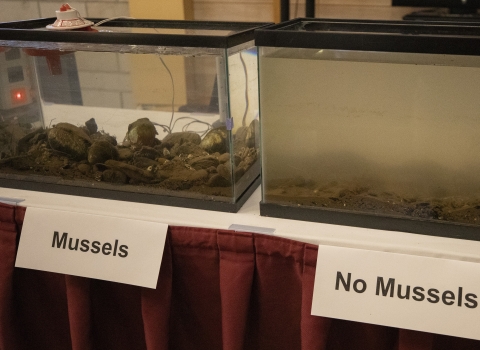Climate change is a complex natural resource management problem because it involves persistent change across large landscapes and is difficult or impossible to address locally. Conditions fueled by or worsened by climate change climate change
Climate change includes both global warming driven by human-induced emissions of greenhouse gases and the resulting large-scale shifts in weather patterns. Though there have been previous periods of climatic change, since the mid-20th century humans have had an unprecedented impact on Earth's climate system and caused change on a global scale.
Learn more about climate change may favor species new to an area over those that have been longtime inhabitants. These changes can result in ecological transformation—a thorough system makeover that can occur when species move due to changes in their surrounding environment.
Recognizing the need for coordinated action, representatives of several natural resource management agencies met in 2018 to develop a framework to address ecological transformation. The group is using this framework to develop management guidance for resource managers. Along with the U.S. Fish and Wildlife Service, participating agencies included:
- Bureau of Land Management
- National Oceanic and Atmospheric Administration
- National Park Service
- U.S. Forest Service
The U.S. Geological Survey provided scientific guidance.
Members devised a Resist-Accept-Direct framework to help resource managers collaborate across landscapes and jurisdictions (federal, state, local, tribal and private).
A Response Framework
The Resist-Accept-Direct framework allows managers to choose from three management responses:
- Resist the direction of change, by working to maintain or restore function, structure structure
Something temporarily or permanently constructed, built, or placed; and constructed of natural or manufactured parts including, but not limited to, a building, shed, cabin, porch, bridge, walkway, stair steps, sign, landing, platform, dock, rack, fence, telecommunication device, antennae, fish cleaning table, satellite dish/mount, or well head.
Learn more about structure or composition, based on historical or acceptable current conditions. To resist means to return a system to its historical condition. - Accept the direction of change, by allowing the change to occur without intervening. To accept is to allow nature to change conditions without any management response.
- Direct the change, by actively shaping managing processes, function, structure or composition toward a new desired condition. To direct is to take management actions to forcefully move a system toward some condition that humans find desirable.
Case Study: Blackwater Refuge
Blackwater National Wildlife Refuge in Maryland, established in 1933 to protect migratory birds, consists of more than 30,000 acres of rich tidal marsh, flats, mixed hardwood and loblolly pine forests, managed freshwater wetlands and croplands. The Blackwater River spans the single largest area of brackish marsh within the Chesapeake Bay watershed. The refuge is recognized as a Wetland of International Importance and an Internationally Important Bird Area. Refuge wetlands also provide storm-surge protection to residents of lower Dorchester County.
Using a collaborative report—Blackwater 2100—as a basis, staff at the Blackwater National Wildlife Refuge use all three RAD strategies.
Blackwater Refuge: Resist
A good example of the Resist strategy can be seen at the refuge area called Shorter’s Wharf, which provides historic habitat for the eastern black rail and the salt marsh salt marsh
Salt marshes are found in tidal areas near the coast, where freshwater mixes with saltwater.
Learn more about salt marsh sparrow, among other bird species.
Managers know the fix is temporary —as solutions using the Resist strategy almost always are. If sea-level rise outpaces the ability of the marsh to trap sediment and grow, the project may last only a decade or two. It is important to keep in mind long-term goals when using the Resist strategy.
Blackwater Refuge: Accept
Phragmites, an invasive wetland grass that chokes out native plants and wildlife habitat, is widespread across the refuge, making it difficult to control. Sea-level rise tied to climate change has made the problem worse.
As former high grounds subside and change into tidal wetlands, higher salt levels in the soil are killing trees. The tree die-off appears to give phragmites a foothold in these areas where it wasn’t seen before. Under these circumstances, refuge staff chose to Accept the change brought on by phragmites. While the plant does not provide the type of wildlife habitat needed by many birds and animals, it does reduce erosion, trap sediment and buffer storm surges, benefiting Dorchester County residents.
Blackwater Refuge: Direct
Because fighting phragmites is so hard once it becomes established, the refuge is using the Direct strategy to try to head off the invasive grass before it reaches new sites.
At one upland site, the refuge has removed trees from an area likely to succumb to sea-level rise in the near future. This may help promote formation of marsh vegetation and help reduce phragmites encroachment. Staff hope this may be a tool to help guide upslope migration of marshes in response to sea-level rise.
Resist-Accept-Direct Resources
Resist-Accept-Direct Framework (National Park Service)
National Park Service Report (pdf)
RAD Information Links (from the American Fisheries Society & the Wildlife Society)
“The Trouble with Naturalness: Rethinking Park and Wilderness Goals,” Cole and Aplet (2010)(pdf)
RAD webinar (from Schoodic Institute at Acadia National Park)
The Climate Toolbox
Podcast – Responding to Climate Change USFWS Senior Ecologist Scott Covington and NPS Coastal Geology and Adaptation Coordinator Rebecca Beavers spotlight some key efforts to slow the effects of climate change on public lands. (Engineering With Nature, Episode 5)
Other Agencies Addressing Climate Change
National Park Service
U.S. Geological Survey
U.S. Forest Service
National Oceanic and Atmospheric Administration
Bureau of Land Management







